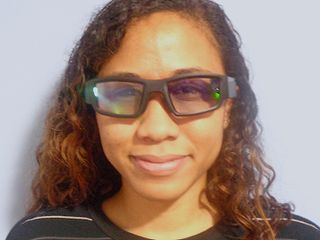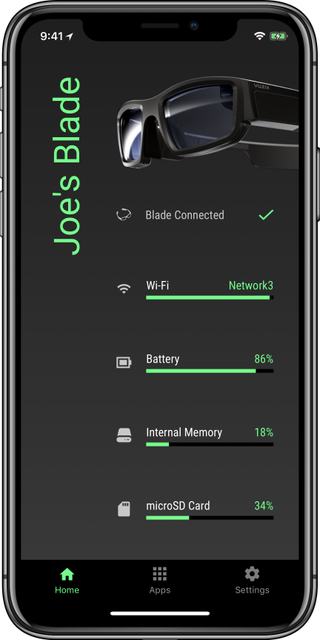Vuzix Blade AR Smart Glasses Hands On: Amazon Alexa, Video & Other Clever Uses

Vuzix Blade, AR smart glasses with the look of Oakley sunglasses and the power of Amazon Alexa and Google Assistant, are finally hitting the consumer market later this month for $999 without prescription and "under $1,200" with prescription. Armed with a quad-core ARM processor, an AR display in the right lens, a touchpad, voice control, and its own iOS and Android companion app and app store, the Blade gives you a lot of ways to control it. We've tried them out for ourselves, and while they’re still a ways off from turning users into fashionistas, its software makes the glasses stand out for all the right reasons.
The Look
It’s hard for me to get on board with the Vuzix Blade’s thick, black plastic styling. At best, they look like an extra chunky version of traditional men’s Oakley sunglasses—which I’m not a fan of to begin with—without the tint. Sure, they’re a more socially acceptable upgrade compared to other AR/MR glasses like Microsoft Hololens or the now enterprise-only Google Glass, but they still don’t look like something I’d voluntarily wear in order to look good. And they’re not nearly as cute as North’s Focals smart glasses.
The glasses’ temples are quite wide and gently scraped across my hair and head as I pulled them on and off. While I can feel the thick pieces resting at the back of my head, they didn’t bother me. The glasses were even more comfortable than wearing a headband.
I wore the Vuzix Blade on and off for about 45 minutes. It didn’t weigh my head down or feel too heavy. But it did irritate the bejeezus out of the bridge of my nose. The nose pads are thick rubber and gave me a feeling that I can only compare to what you feel when someone points a finger between your brows but doesn’t actually touch you (if you’ve never done this before, try it. It’s exactly how my nose felt while wearing the Blade). As a result, I felt like taking the glasses off every couple of minutes and rubbing the bridge of my nose back to normalcy.
Vuzix said the end goal is for the Blade to be as sleek and functional as the glasses used in the Kingsman movies. At this iteration, I have to say that Eggsy looks better in his version of AR glasses than I do in the Blade. But in the picture below you can see Vuzix’s vision for subsequent models, the Blade 2 and Blade 3.

How It Works

The Vuzix Blade has to be paired with your smartphone via Bluetooth to work. It always has to know your location because the device has to know it’s physically next to you in order to function, I was told. After the Blade is connected, and you download Vuzix’s companion iOS or Android app, the smart glasses can display incoming notifications from any of your smartphone apps. The companion app will also give users access to Vuzix’s app store, the only place where you can download apps, like Amazon Alexa for the Blade.
I’m sorry; I can’t not say it: Navigating the Blade’s menu worked just like Saiyan scouters in Dragon Ball Z. With my finger, I touched a nondescript plastic touchpad on the glasses’ right arm. To scroll through the menu, a row of icons on the bottom of the display, I swiped on the touchpad. A two-finger hold brought me to the Home menu, featuring the date, time and any notifications. After a while of continuous use, due to my historically limited upper-body strength, my arm got a little tired from working the glasses.
Stay on the Cutting Edge
Join the experts who read Tom's Hardware for the inside track on enthusiast PC tech news — and have for over 25 years. We'll send breaking news and in-depth reviews of CPUs, GPUs, AI, maker hardware and more straight to your inbox.
Using display Cobra engines and a small projector on the temple, the Blade projected crisp, colorful text and images in front of my eyes. The default screen showed “Home” in big white letters, while a neon green box held the date and time.The bottom of the display featured a row of colorful icons representing apps.
Already-Impressive Array of Apps
Vuzix claims to have 400 developers a month registering to develop Blade apps. In my demo, I got to try out the Blade’s texting capabilities, gaming and betas for Amazon Alexa and a top video streaming service. It gave me a taste of what the Vuzix Blade app store will have upon the Blade’s consumer launch. It’s clear Vuzix was waiting for the right amount of apps, both in quality and quantity, before releasing the Blade to the general public.
When I tried the Blade, they were still developing the iOS texting app, so I used an Android phone. When I received a text, a pop-up dropped down from the top of the display, with a preview of the message written in white, including the sender and emojis. There’s no messages app, everything goes through your smartphone so you use your phone’s SMS app, Google Hangouts, WhatsApp or another messaging client to chat.
I tried out a teleprompter and karaoke demo where words streamed in front of my eyes like the story appears in a Star Wars opening crawl. While this appealed to me as a newfound karaoke fan (ever since my six-year-old niece did a of “Ice Ice Baby” this Christmas), there are greater possibilities for this technology. Imagine doing a public speech with your words right in front of your eyes, or this being used as a translator, instantly decoding foreign languages.
When I demoed the beta video streaming app, the company was still in the process of making the UI more seamless. But the bright colors of Rainy With a Chance of Meatballs were impressive on such a tiny display from a relatively light device. However, the image did fade out a little if I was looking at something black. The final app should be ready by the end of January.
The Blade’s Alexa compatibility has gotten it a lot of attention. But with North’s Focals also boasting the voice assistant, Blade will need to work intuitively with Alexa to stand out. When I tried out an Alexa Beta demo, I had to tap to speak and then tap when I was done speaking. It worked on the first try multiple times, but all the tapping isn’t necessarily carefree. However, Vuzix told me they are working on making Alexa voice-enabled through the Blade. And the Blade will also feature Google Assistant; although, I didn't get to try that out.
Final Thoughts
Vuzix Blade is a bit off putting to the more style-conscious due to its chunky look, but it was surprisingly lightweight on my face. While it did irritate my nose, perhaps I can get use to it, especially if Vuzix delivers enough functionality and fun through its app store. We’re also interested in testing out that 8MP camera, battery life and long-term application. We’ll be reviewing all this in the Blade in detail later this month, so stay tuned.
Scharon Harding has a special affinity for gaming peripherals (especially monitors), laptops and virtual reality. Previously, she covered business technology, including hardware, software, cyber security, cloud and other IT happenings, at Channelnomics, with bylines at CRN UK.
-
TwoSpoons100 "Vuzix Blade is a bit off putting to the more style-conscious due to it’s chunky look"Reply
Lets be brutally honest here: they're just ugly. They look like the kind of nasty rubbish they hand out at 3d movies. -
cryoburner I wouldn't necessarily say they look "ugly", but they are rather chunky. The area that could use the most improvement would be around the bridge of the nose. Perhaps they keep some electronics in there, but they really need to work on thinning that area up, and moving those things elsewhere. That's something the North glasses from the other article appear to get right. They actually manage to make them look a lot more like a normal pair of eyeglasses, rather than chunky sunglasses. Ideally, they should keep all electronics in the sides, with only maybe a pair of thin wires connecting a battery in one side to the processing/display unit in the other, and focus on making the entire area around the lenses thinner.Reply
Most Popular




